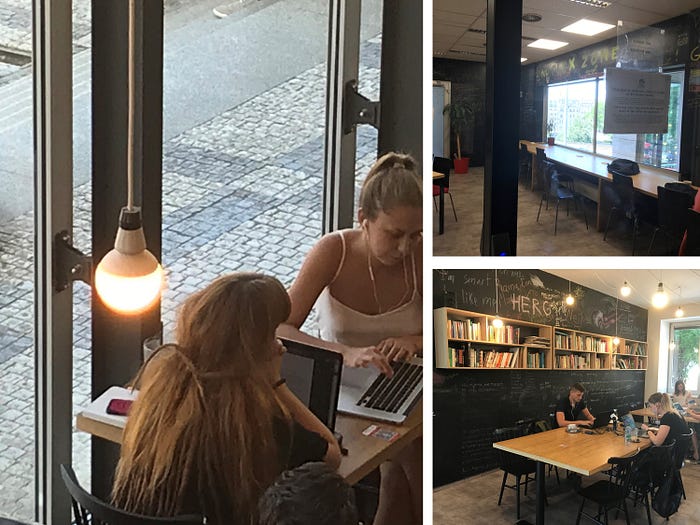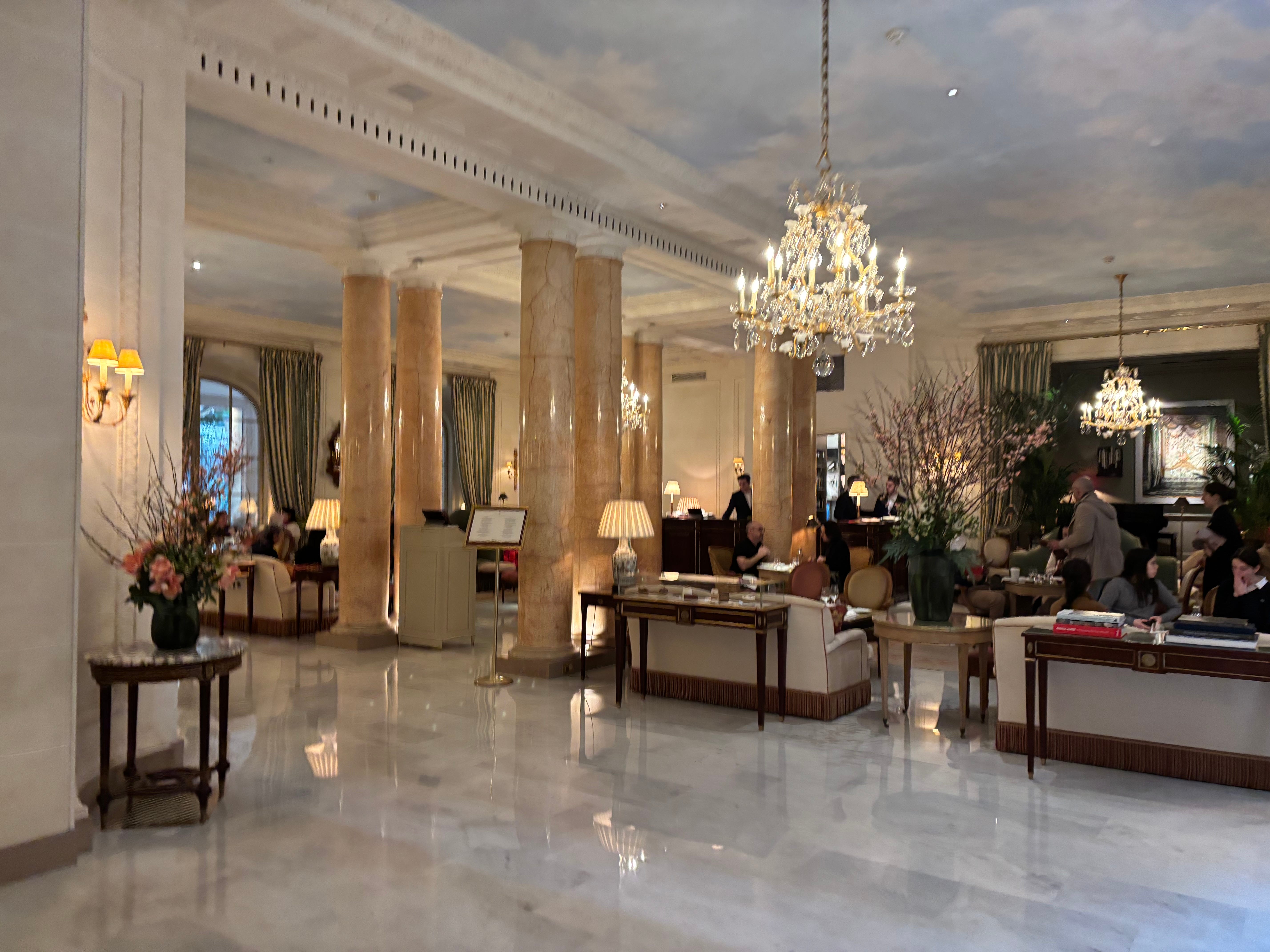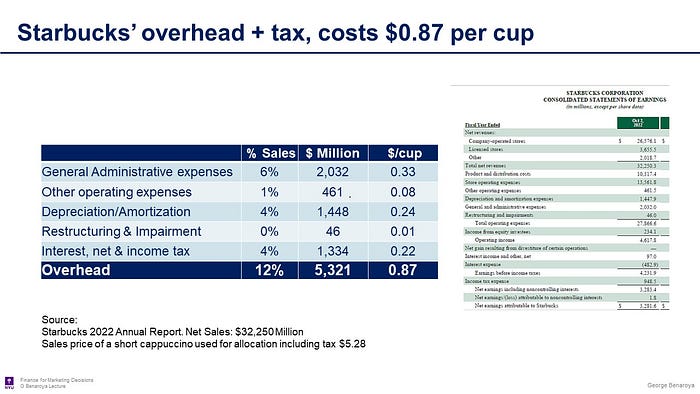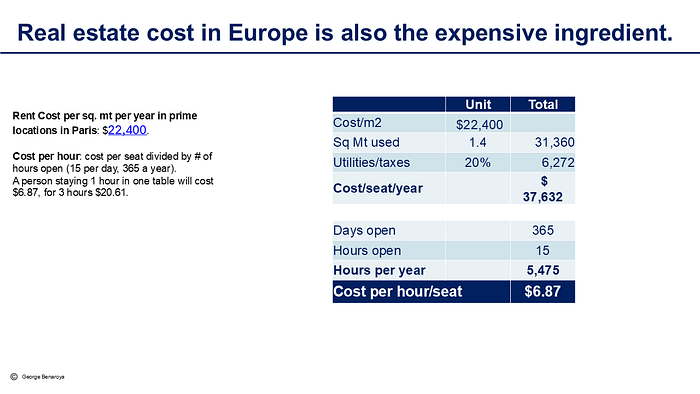
Starbucks’ cost for a coffee is $1. Unless you sit
The cost for Starbucks to make a cappuccino is $1. The total cost, however, is over $10 when you stay for a while in parts of Manhattan. Bulgari’s annual rent is $60,500 per meter at 730 Fifth Ave ($5,500 per foot). I travel extensively for work; I’ve visited every country in the world. Once, I was visiting Hong Kong, and my colleague took me to a prime spot with a McDonald’s. I asked him how much the rent was, and when I learned it was $2,750 per foot, I asked for a napkin to do the math.
Starbucks’ cost for a cappuccino
$0.30 for coffee and milk
The retail cost for Starbucks coffee, milk, and sweetener is $0.30. That is how much you would spend if you did it at home, using the proper ratios of coffee on a proper ceramic cup. Add 7 more cents if you use a paper cup, stir, and lid. Details on the calculation are at the bottom of this article.
$1 including Direct labor
The total cost for the barista, cashier, and support staff, including taxes and benefits, is $0.70. I’ve updated this article since it was first published in 2019; the hourly rate in 2023 is $20. Thus, the total marginal cost for Starbucks to make a cup of coffee is $1.00 ($0.30+$0.70).
Overhead Expenses: $0.64
The 2022 Annual Report shows that SG&A expenses at Starbucks are 12% of sales or $0.87 per cappuccino. This includes advertising, administrative (headquarters), depreciation, amortization, R&D, and all other expenses, such as income taxes and interest.
Store rent cost: $2.89 per hour, $9 for 3 hours
The Starbucks we picked was near the NYU midtown campus. The average rent in that block was $878 per square foot, plus 20% for utilities, depreciation, and other expenses. While the space occupied by a seat is 7 square feet, the rule of thumb is to double that to account for the entrance, corridors, storage room, and restrooms, if any. Thus, the occupied space we used was the nationwide average of 15 square feet, at an annual cost of $15,800 per seat. This location is open 15 hours a day, so the cost per hour is $2.89. When you stay for 3 hours, that adds up to $9 for rent.
Buying a cup of coffee is a real estate transaction
While office space in terms of “hot desks” which more closely resemble a spot at Starbucks are available at a cost of $21 per hour, they are typically not available on short notice. Only the four properties listed at the bottom were available.
Limited space at this Starbucks location
Starbucks loses money when anyone sits at a table for over an hour in this part of Manhattan. But that is not a problem; there are only 6 seats, with no outlets, and the Google maps data shows that the average person spends 25 minutes. This also suggests most consumers spend 5 minutes, and a few stay there for hours (I tested the free Wi-Fi, and it was operating at 38.3 Mbps, faster than at work).

Marginal and Fixed cost
Once per week, I teach a Finance class at NYU (read more). I use this story to explain the concept of marginal cost ($1 to make a cup of coffee) and Fixed Cost-rent and depreciation. During the pandemic, some NYC restaurants would limit the time you could stay. On weekends, I also teach Finance to high school students on a Pro-Bono basis. Many students, after learning this, went on to test the stores in New Delhi and Beijing. They stayed three hours and were politely asked whether they wanted something else but were not kicked out. In my lectures, we discuss how to encourage clients to leave or leave them alone and consider it a cost of doing business.
Why is Starbucks at expensive, prime retail locations?

At Cafedu in Prague, customers can rent space per minute. During a trip to Europe in 2019, I was fascinated by Starbucks locations in Prague’s Castle as I was previously by the one in Beijing’s Hidden city. (The best deal is McDonald’s €1 cappuccino at Barcelona’s La Rambla). Why would Starbucks be at such prime locations? Traffic. Their 2018 annual report states, “Starbucks company-operated stores are typically located in high-traffic, high-visibility locations.” Starbucks’ operating margin is 16%. They sell lots of coffee to people on the go, which is how they make money. The profitability of Starbucks in 2018 in Europe was one-third of that in North America. One reason may be that many transactions, discussions, and debates are conducted in Europe at cafés. People tend to stay longer. The price for those sitting at “the bar” instead of at a table is sometimes lower. Many cafés are introducing the concept of a pay-per-minute scheme. I liked Cafédu in Prague, but I wouldn’t pay per minute, it’s a better deal to pay a flat fee for coffee.

Cafés and Real Estate in Europe (Upodated January 2025)
When you sit at a café in Paris, you’re not just paying for coffee — you’re paying for prime real estate. Annual rents per square meter in Paris can reach €22,400, according to Milano Finanza, citing data from BNP Paribas and CBRE. Each seat in a café takes up around 15 square feet (1.4 square meters), including corridors and shared spaces, as I reviewed above. At €22,400 per meter, that’s €31,360 per seat. With the La Paix café open 5,475 hours a year (15 hours daily, 365 days), the cost per hour to occupy that seat is €5.72 instead of $2.93 at Starbucks.
The cappuccino at Le Bristol cost €18 instead of $6, thus the math remains the same. When you stay for 3 hours, they lose money.

Another cost to bear in mind when looking at a cafe is the cost of furniture and equipment. High-end hotel interiors, including furniture and design elements cost up to US$2,244 per square meter, according to total outfits. Wikipedia notes that ultra luxury properties, such as the $1.4 Billion Mardan Palace cost $7777 per square meter. While Le Bristol is not the Mardan palace, when you look at the photos, you will see that is top class. Trust me, I was there.



_________________________________________
Details on cost calculation
Coffee milk and Sweetener $0.30

Total direct cost with labor and benefits $1.00

Overhead, all other expenses and income tax cost, $0.87 per cup

Real estate cost is $3 per hour or $9 for 3 hours

